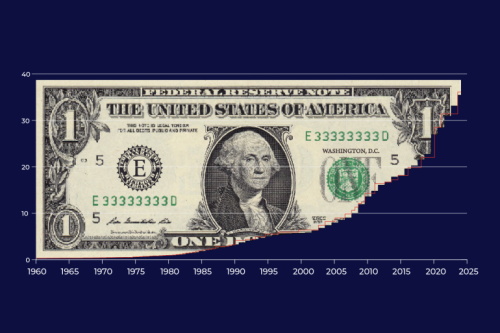Corporate Debt Bomb: 60% of US Profits Tied to Government Spending

While Wall Street celebrates record-breaking corporate earnings, a looming concern is quietly growing — US companies are increasingly resembling "fiscal parasites," with their profits heavily dependent on government spending and policy support. Data from Q3 2024 shows that nearly 60% of corporate profits in the United States stem directly or indirectly from public sector spending programs, including defense contracts, Medicare allocations, infrastructure investments, and tech subsidies. Should fiscal policy shift toward austerity, this profit model may face a catastrophic collapse.
An Invisible Profit Bubble
Beneath the surface of seemingly robust corporate earnings lies a hidden truth: government spending is propping up profits. According to the International Monetary Fund, more than 60% of US corporate profits are tied to government activity. At the same time, corporate profits are becoming less reliant on traditional market forces such as private investment, consumer demand, and export performance, all of which have shown diminishing influence. This structural dependency poses a serious problem — companies are not earning through innovation or market expansion, but rather by "feeding off the public purse."
However, the US government’s fiscal condition is far from healthy. Federal spending has surged to $7 trillion annually, while revenues remain at around $5 trillion, resulting in persistent annual deficits of 6–7% of GDP. Government spending now accounts for roughly one-third of GDP, and the government's ability to “generate blood” — its fiscal self-sufficiency — is steadily eroding. More alarmingly, total federal debt has exceeded $36.2 trillion, with $9.2 trillion (25.4%) maturing in 2025. As debt rollover risk intensifies, fiscal tightening is no longer a matter of choice — it's becoming a necessity.
Companies with “Fiscal Sensitivities”
In the past, companies could rely on globalization to diversify risk. Now, that safe harbor is faltering. On one hand, the Trump administration has proposed sweeping budget cuts in defense, healthcare, and infrastructure. On the other, the return of protectionist trade policies and tariffs is again unsettling global trade, limiting companies' access to foreign markets. Without government contracts and subsidies, many firms may quickly slip into loss-making territory.
Even more dangerous is the interest rate environment. Since the zero-rate frenzy that began during the pandemic in 2020, companies went on a debt binge, directing much of that capital into stock buybacks and executive bonuses instead of long-term productive investments. By 2024, US non-financial corporate debt exceeded $10 trillion, and total corporate debt hit $12.1 trillion. High-yield bonds — aka “junk bonds” — now make up 23% of the total. Between late 2025 and mid-2026, a major wave of corporate debt maturities is coming due. If the Fed maintains high interest rates to curb inflation, a wave of corporate defaults will be unavoidable, potentially impacting sectors like manufacturing and services — and leading to the loss of over a million jobs.
The trend has already begun. Corporate bankruptcies in the U.S. climbed by 15% in 2024 compared to the previous year, as rising borrowing costs pushed many companies beyond their financial limits. Goldman Sachs CEO David Solomon noted that the current level of uncertainty is excessively high, significantly disrupting corporate decision-making in areas like investment, spending, and strategic planning — a trend that could soon weigh on the broader economy.
The Fed’s Dilemma
Mounting fiscal pressures in the U.S. have significantly constrained the Federal Reserve’s room for maneuver. The Fed now holds $5.2 trillion in US Treasuries, making up 60% of its total assets. To fight inflation, continuing to buy Treasuries would stoke further price increases; but halting purchases would send interest rates soaring and significantly raise government borrowing costs. This “damned-if-you-do, damned-if-you-don’t” situation is eroding the Fed’s independence, forcing it to waver between price stability and fiscal support.
Meanwhile, the US social security system is nearing its limits. According to the latest projections from the Social Security Administration, by 2033 — when the youngest baby boomers turn 70 — the Old-Age and Survivors Insurance Trust Fund will be depleted. Without reform, this would trigger an automatic 24% cut to statutory benefits. Even if disability insurance funds are combined with retirement funds, insolvency would only be delayed to 2034.
Infrastructure and Competitiveness Crisis
Beyond fiscal and corporate debt issues, America's aging infrastructure is another "hidden liability" for the economy. The American Society of Civil Engineers has given the nation’s infrastructure an overall grade of C-, estimating that $2.6 trillion is needed to bring systems up to par. Aging bridges, failing water systems, and traffic bottlenecks are undermining operational efficiency and the long-term competitiveness of US companies. With tightening public finances, investment in these critical areas is falling short — feeding a vicious cycle.
From Fiscal Dependency to Systemic Risk: Who Pays the Price?
Corporate profits that lean ever more heavily on government spending may appear stable but are actually dangerously fragile. If fiscal stimulus wanes, interest rates remain high, or concerns about Treasury defaults intensify, profits could collapse rapidly. And it will be ordinary people who bear the brunt — through job losses, rising living costs, and shrinking retirement benefits — all of which are likely to unfold in the coming years.
History has shown time and again: debt doesn’t disappear on its own. It either moves through the system or erupts all at once. When the only policy tools left are “recession” and “default,” someone will inevitably pay the price.
The Way Forward: Risk Awareness as the First Step
For companies, reducing reliance on government spending and diversifying income sources is the only sustainable path to long-term profit growth. Whether through increased R&D, boosting export capacity, or accelerating digital transformation, firms must build revenue models that are fiscally independent.
For investors, a company’s “fiscal sensitivity” should become a core metric in risk assessment. Firms heavily reliant on government contracts and subsidies should have their earnings stability and market valuation reassessed.
And for policymakers, now is not the time to relax and add more leverage. It's time to rethink the relationship between public finance and corporate America. Otherwise, once the “corporate debt bomb” explodes, it won’t just be companies falling — it could shake the very foundation of the US economy.



